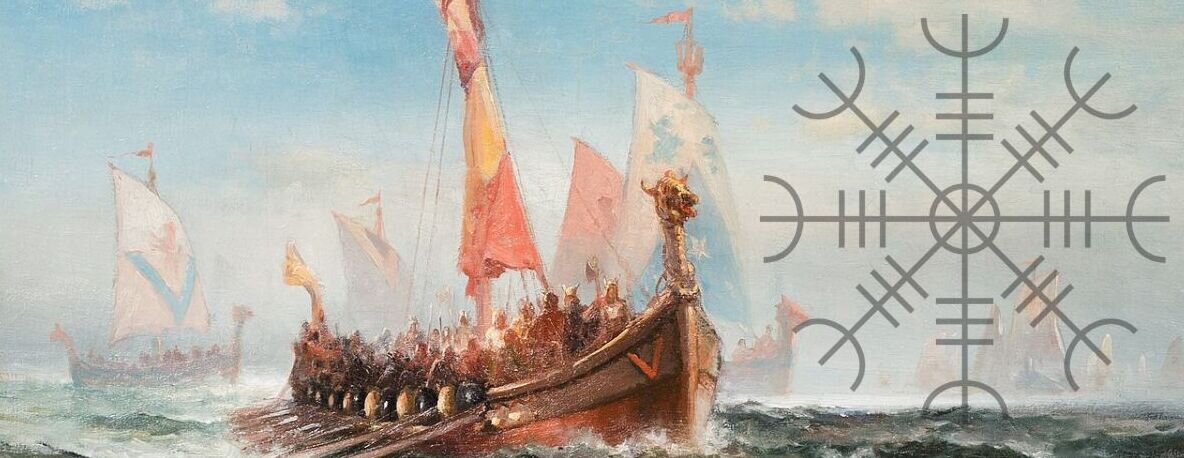The Helm of Awe is considered an Icelandic magical stave. The Helm of Awe is made up of a circle surrounded by eight spikes or z-runes as its arms. This rune is called Algiz, from the Elder Futhark runic alphabet. It has the transliteration of the letter "z."
This magical stave is also known as the Helm of Terror, Ægishjálmur in the Icelandic language or Œgishjalmr in Old Norse.
The name of the Norse runic symbol that makes up the Helm of Awe is rumored to have derived from the magical giant Aegis, who ruled over the sea. Aegis was not a kind giant. Instead, he was jealous and angry, smashing into ships and pillaging all the treasure for himself.
However, there is no proof regarding his connection to the symbol. Some sources state that it is because the sea is an unstoppable force, and that is what Aegishjalmur represents: strength.
How do you Pronounce Aegishjalmr (Helm of Awe)?
This powerful and mysterious Norse symbol looks intimidating, but it’s not as difficult to pronounce Aegishjalmr as you think. Try pronouncing the Helm of Awe as EYE-gis-hiowlm-er.
If you’re struggling, you can try using this YouTube video.
What is the Meaning of the Helm of Awe?
This important Viking symbol comprises the same eight magical solid runic symbols. Together, they combine to give the warrior courage, strength, and protection even in the bloodiest battles. Norse mythology suggests the Helm of Awe was a vital form of protection against enemies.
Warriors and wayfarers received protection and victory when wearing the powerful Helm of Awe, or so the myths say. These magic symbols have other uses, claiming they can also banish a person’s fears.

How was the Helm of Awe Used?
Norse warriors would often draw the Helm of Awe in blood on their forehead as a critical ritual before battle.
Sometimes this was done in lead, sometimes in blood. Vikings believed the symbol would interact with the pineal gland (the center of the Viking soul).
Does Helm of Awe Represent Evil?
Viking symbols were not for evil but for some form of protection.
There are many diverse magical symbols in Norse mythology. All were created to provide direction like the pathfinder Vegvisir, or protection, like the Helm of Awe.
With the importance of courage and protection given to the Aegishjalmur, it was very far away from representing evil.
The origins of the Helm of Awe reinforced this view. The Poetic Edda is an essential reference for important Nordic symbols and Viking mythology. In the 16th stanza, Fáfnismál talks of the destructive dragon Fafnir, The angry dragon, cursed by Andvari’s gold, claims the source of his fearsome might comes from the Helm of Awe.
He declares:
The Helm of AweI wore before the sons of men defense of my treasure; Amongst all, I alone was strong, I thought to myself, For I found no power a match for my own.
Fáfnismál – Voluspa Org
So as you can see, the Helm of Awe wasn’t a sign of evil when represented through the strong and fearsome dragon Fafnir; instead, it was a symbol of might.
Where is the Helm of Awe Mentioned?
- The Aegishjalmr, or the Helm of Awe, makes a significant appearance in the Old Norse poem Fáfnismál, found in the Poetic Edda (the 1200s).
- Nordic religion is full of important symbols like the Helm of Awe, which might be why it’s also credited in the Galdrabók (a 17th-century Icelandic grimoire of 47 spells and sigils/staves).
- The 1847 Huld manuscript also contains the symbol for reference in the sagas.
The Helm of Awe Tattoo Meaning
Whether due to popularity or their powerful and magical attributions, Viking tattoos like the Helm of Awe tattoo remain a prominent modern symbol of might, protection, and courage.

